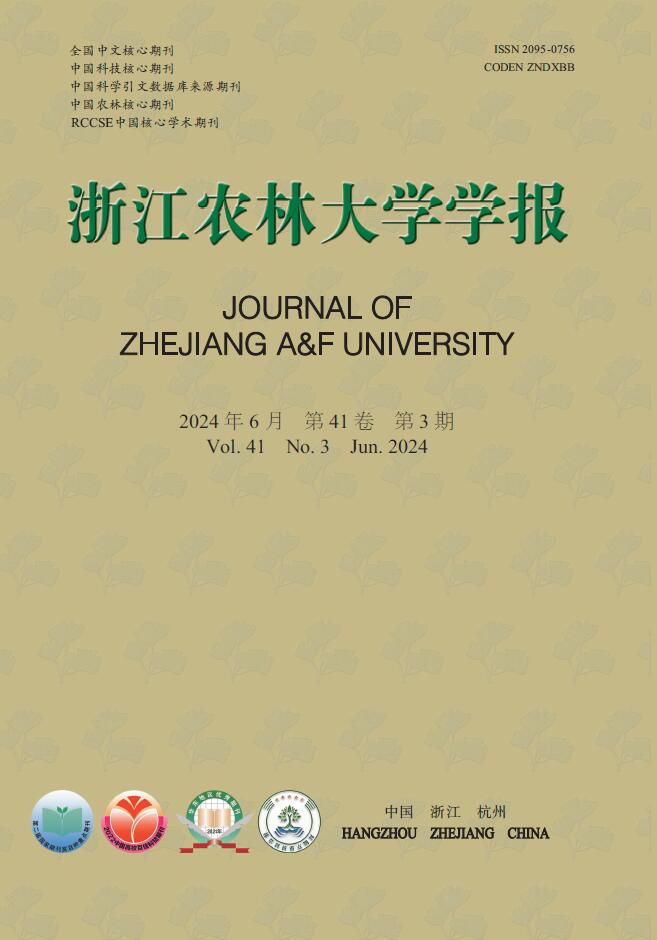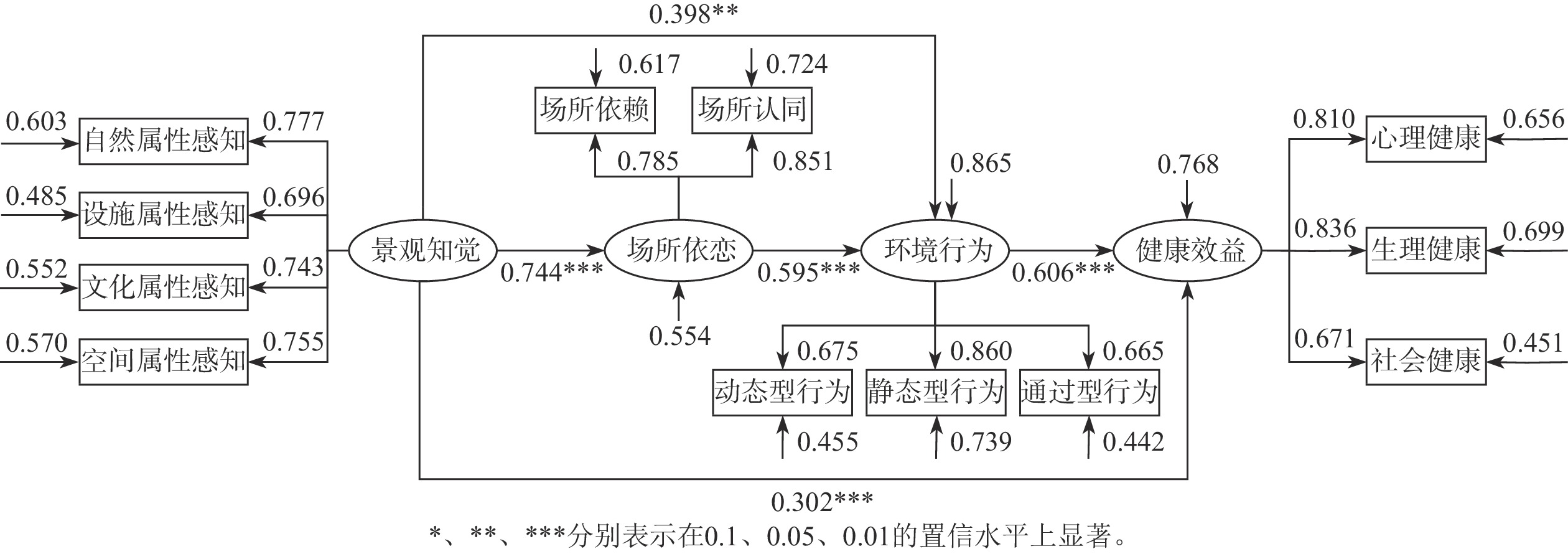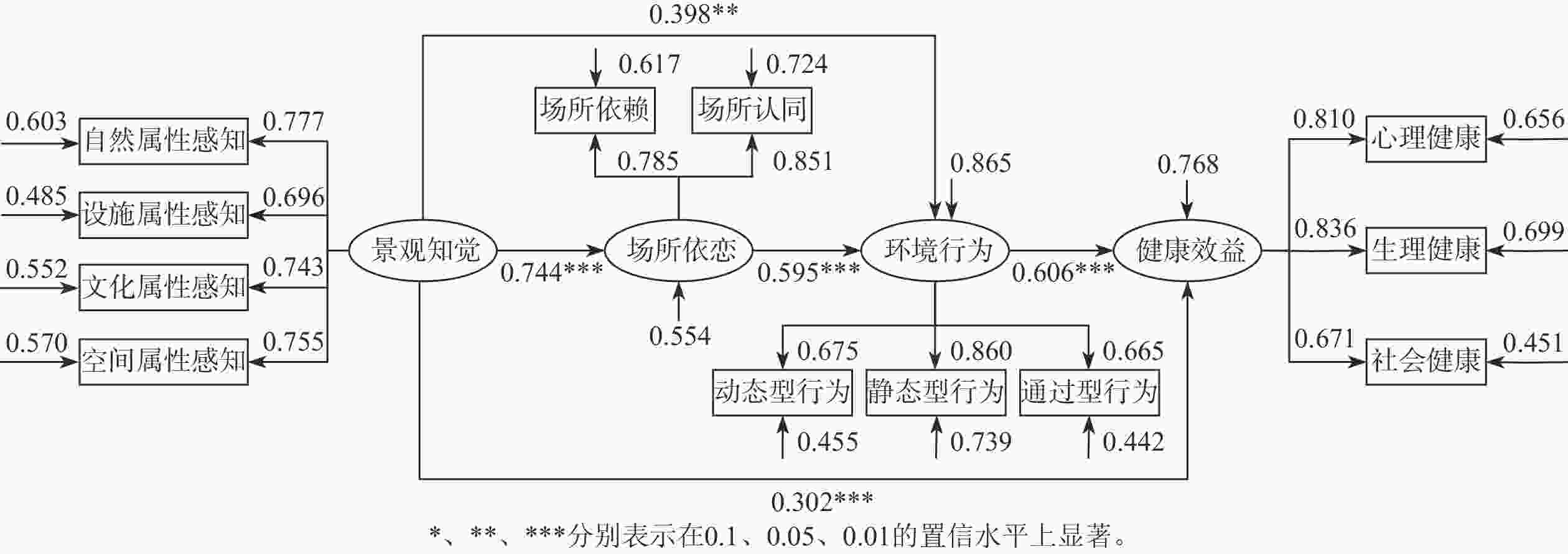-
城镇化快速发展的背景下,城市压力环境给居民健康带来了严重影响[1]。森林公园作为满足城市居民景观审美、活动需求的重要绿色组成,在缓解心理压力、解除生理疲劳等方面有积极作用[2],是发展森林康养创新业态的重要载体之一[3]。通过研究森林公园与游憩者健康效益评估的作用机制,对于推动森林公园健康景观规划设计具有重要意义。在森林公园健康效益研究方面,国内外学者主要围绕恢复性环境[4]、景观特征[5]、视听感知[6]等影响路径,进行森林公园要素识别、健康效益量化等研究[7],并总结出由环境特征、健康促进结果和介于两者之间的中介作用所构成的健康效益评估影响路径[8]。森林公园作为自然与人文系统相互结合的绿色空间载体[9],对游憩者健康的影响不应仅局限于“环境”的物理特征,更应关注游憩者与空间交互所形成的主观感知与个人情感,甚至由个体主观意义所产生的体力活动、社会交往等环境行为趋势[10]。然而,现阶段对于森林公园健康效益的量化研究集中在相关性或单一中介的影响作用,较少结合游憩者连续的场所感知与环境行为视角对森林公园健康效益的内在转化机制进行实证探究[11],并且由于森林公园健康景观的相关评价指标体系尚不完善[12],导致这种相互依赖的影响机制仍未得到充分理解。本研究以福州国家森林公园为研究样地,从游憩者景观知觉和场所依恋出发,引入环境行为视角,构建了森林公园健康效益评估概念模型,结合问卷调查法、探索性因子分析法和结构方程模型分析法,解析景观知觉、场所依恋、环境行为与健康效益评估四者之间的影响路径与作用机制,提出森林公园健康景观优化建议,为探究森林公园健康效益影响机制提供新的理论视角和实践参考。
-
福州国家森林公园位于福建省福州市晋安区新店上赤桥,总占地面积为859.33 hm2,是国家十大森林公园之一。整体园区自然景观资源丰富,负氧离子含量高,森林茂密,植物种类繁多,拥有良好的森林资源条件及相对完善的基础设施,被誉为“福州之肺”。园内丰富的动植物资源、水体与地形为游憩者对森林公园量化评价提供了有利条件。公园地貌以低山丘陵为主,海拔为48~507 m,属亚热带海洋性季风气候,年均降水量为1 394.3 mm,年均气温为19.6 ℃。
-
游憩者的心理认知因素是构建环境与人体健康之间的重要枢纽。优美的景观环境可以缓解游憩者疲劳的生理状态、恢复积极的心理状态[13],景观知觉是游憩者在景观环境中进行自然体验、游憩活动时,产生的认知度评价与感知[14],反映了游憩者与环境进行互动的结果,在一定程度上决定着环境行为的意向和态度[15]。其次,唤醒理论和自我调节态度理论为游憩者感知与情感关系构建了联系,感知和评价是对环境刺激及情绪产生的因素[16],情绪的启动通过影响情感响应的发生,进一步影响个体行为的意向和态度[17]。同时,当个人对绿地环境产生功能性依赖时,这种情感上的依恋也可能通过激起美好回忆而获得愉悦的心理感受和舒适的生理恢复等积极的健康恢复效益[18]。最后,环境行为学理论强调了自然环境与人体行为是一种相互作用的影响关系,为探寻游憩者对环境空间使用的活动状态提供了条件[19]。游憩者对环境的生理实践过程是健康效益发挥的重要途径之一,人类具有亲环境心理与行为,同时行为活动具有独特的健康恢复属性[20],且将在自然环境中得以强化,游憩者在环境支持的行为活动下,会不同程度地促进个体健康水平[21]。
森林公园作为“环境−行为”相互作用的综合体,其健康效益影响路径的本质是通过影响游憩者对景观产生感知评价,同时诱导个人情感的产生,并激发环境行为活动意愿,进一步获得积极的健康恢复效益,最终形成游憩者“感知评价—情感响应—行为实践”互动过程所产生的健康促进结果[22]。景观知觉作为感知评价变量,是森林公园环境发挥健康效能的启动变量,场所依恋作为个人情感上的归属与联结,是森林公园环境发挥健康效能的情感响应变量,环境行为交互的是生理性的行为空间,是森林公园环境发挥健康效能的实践响应变量,并同时受到景观知觉和场所依恋的主观心理因素影响,健康效益是森林公园发挥健康效益的启动结果,最终构建森林公园健康效益评估概念模型,并提出以下假设:景观知觉对场所依恋有显著的正向影响(Z1);场所依恋对环境行为有显著的正向影响(Z2);环境行为对健康效益评估有显著的正向影响(Z3);景观知觉对环境行为存有显著的正向影响(Z4);景观知觉对健康效益评估有显著的正向影响(Z5);场所依恋对健康效益评估有显著的正向影响(Z6)。
-
本研究调查问卷包括人口统计学特征调查、景观知觉度量表、场所依恋量表、环境行为量表以及健康效益评估量表(表1)。其中,景观知觉度量表参考刘凡等[8]以及黄思颖等[23]的景观知觉自然度和场所知觉研究,并咨询20位风景园林学领域专家有关景观知觉度评价指标的意见,结合福州国家森林公园的实地情况,最终提出了19项评价指标。场所依恋量表主要借鉴WILLIAMS等[24]的研究,包含场所依赖、场所认同2个维度8个测试项。环境行为量表主要借鉴彭慧蕴等[25]的研究,包含动态型行为、静态型行为、通过型行为3个维度8个测试项。健康效益评估量表参考心境状态量表(POMS)、自评健康评定量表(SRHMS)中的健康问项[26],包括心理健康、生理健康、社会健康3个维度9个测试项。问卷中的测量题项均采用李克特7分制量表法。
变量类别 测量题目 参考文献 景观知觉度 植被生长良好、轮廓线富有变化(A1),能听到很多鸟或昆虫的声音(A2),有各种各样动植物种群(A3),有丰富的地形(A4),水景优美、观赏性强(A5),道路步行系统流畅(A6),道路铺装材质舒适、有质感(A7),游憩设施数量充足(A8),构筑物造型丰富、尺度宜人(A9),有清晰标识和安全防护设施(A10),场地注重科普自然、健康教育(A11),建筑物、雕塑、植物能体现当地文化特色(A12),公众在场所中的互动体验程度(A13),场地便利、能体现人性化(A14),景观能激起自我艺术灵感(A15),空间布局合理(A16),空间类型多样(A17),空间氛围安静(A18),空间有一种亲切感(A19) [8, 23, 27] 场所依恋 您觉得公园环境已经成为生命的一部分(B1),公园环境对您有特殊意义(B2),您很认同公园环境(B3),您很留恋公园环境(B4),公园环境是最适合您休闲放松的地方(C1),这个公园的游憩环境是其他地方不能比的(C2),您喜欢公园休憩环境胜过公园内其他地方(C3),在公园环境中最能满足您放松、休憩等需求(C4) [24] 环境行为 主要进行放松、思考和交流(D1),主要进行接触自然(D2),主要进行社会交往(D3),主要进行设施活动(E1),主要进行场地活动(E2),主要进行自由活动(E3),主要进行散步(F1),主要进行跑步(F2) [25] 健康效益评估 缓解紧张或焦虑(G1)、缓解孤独(G2)、增强注意力(G3)、缓解疲劳(H1)、增强自身活力(H2)、缓解身体疼痛(H3)、增强亲子间交流(I1)、增强社交意愿(I2)、提高学习工作生活的积极性(I3) [26, 28] Table 1. Potential variables and measurement questions
-
问卷调查于2023年6—7月在福州国家森林公园内随机抽样发放,调查对象为景区内的游憩者。问卷发放时间在8:00—11:00和14:00—17:00,调研期间气候温和。在进行问卷调查之前,调研人员需确保受访对象对问卷内容的理解,累计发放问卷500份,回收488份,有效问卷450份,有效率92%。采用SPSS 25.0以及AMOS 23.0进行数据分析以及结构方程模型检验。
通过探索性因子分析法构建变量间的相关性矩阵,以确定景观知觉度的影响因素与变量分组的合理性。具体公因子得分函数如式(1)所示。
式(1)中:Fi 表示公因子,βin 是每项问卷评价变量的权重,代表各变量在式中的重要程度。公因子的数量用 m 表示,i代表公因子总数,X代表自变量,测量题项中原始变量的个数用 n 表示。
结构方程模型也被称为潜变量模型,不但能对量表的信度效度进行科学的测量分析,还可对多元变量之间的复杂关系进行解析。本研究主要针对游憩者景观知觉、场所依恋、环境行为和健康效益评估之间的影响关系进行研究,并通过估计整体结构关系模型的拟合度对提出的研究假设进行判定。
-
针对福州国家森林公园景观知觉度19个测量指标的问卷数据进行探索性因子分析及可靠性检验,量表整体KMO (Kaiser-Meyer-Olkin)值为0.830,>0.7 (自由度为231,P=0.000),表明测量题项适合做因子分析。采用主成分分析,根据方差最大旋转法以及碎石图确定评价指标因子数,删除问卷中A6题项(因子荷载值为0.484,<0.5)与A15题项(交叉荷载为0.428,>0.4),最终获得景观知觉度量表的4个稳定结构,累计方差贡献率达73.70%,结果如表2所示。根据各项指标的整体特征,分别命名为自然属性感知、设施属性感知、文化属性感知、空间属性感知。自然属性感知主要是指游憩者对森林公园中植被、动物、地形水体等自然要素的感知。设施属性感知主要是指游憩者对森林公园中道路、游憩设施等人工要素的认知感受。文化属性感知主要是指历史文化景观、乡土植物、环境融入等文化氛围所激发的地方环境积极评价。空间属性感知主要是指森林环境对游憩者形成的一种安静、亲切的空间体验与感受。通过对筛选后的测量因子进行信效度检验,森林公园景观知觉度量表整体与4个维度的可靠性系数均大于0.6,组合信度均高于0.6,此外,测量题项与整体相关性均在0.01水平上显著相关,相关性系数均大于0.3,整体量表具有较好的收敛效度和内容信度。
测量指标 因子负荷 公因子方差 与整体相关系数 平均提取方差值 组合信度 可靠性系数 因子1 因子2 因子3 因子4 因子1 0.584 0.875 0.871 A1 0.795 0.772 0.649*** A2 0.748 0.726 0.619*** A3 0.796 0.654 0.455*** A4 0.796 0.727 0.612*** A5 0.679 0.547 0.542*** 因子2 0.664 0.888 0.885 A7 0.833 0.767 0.552*** A8 0.832 0.773 0.569*** A9 0.837 0.756 0.514*** A10 0.755 0.751 0.613*** 因子3 0.664 0.887 0.900 A11 0.782 0.762 0.656*** A12 0.887 0.849 0.607*** A13 0.753 0.703 0.641*** A14 0.832 0.809 0.667*** 因子4 0.572 0.842 0.874 A16 0.706 0.667 0.650*** A17 0.776 0.777 0.694*** A18 0.824 0.765 0.605*** A19 0.714 0.724 0.704*** 特征值 7.527 2.092 1.693 1.216 旋转方差载入 20.111 18.458 18.024 17.101 旋转方差累计载入 20.111 38.569 56.593 73.694 整体 0.619 0.965 0.920 说明:***表示在0.01水平上显著相关(双尾)。 Table 2. Exploratory factor analysis and examination of forest park landscape perception scales
-
由表3可见:测量量表12个维度的可靠性系数为0.672~0.913,各测量题项与整体均显著相关(P<0.01),量表具有良好的内容效度。“您喜欢公园休憩环境胜过公园内其他地方”和“主要进行场地活动”的标准化因子负荷值分别为0.483和0.470,其余题项均>0.5,所有测量题项的t均达到标准,为11.500~28.072。场所认同和动态型行为维度的平均提取方差值分别为0.482和0.493,其余维度均>0.5,所有维度的组合信度均>0.6。综上所述, 测量量表中除场所认同和动态型行为维度信效度未符合要求, 其余的信效度均达到标准。
变量类别 测量指标 标准化因子负荷 t 平均提取方差值 组合信度 可靠性系数 景观知觉度 自然属性感知 A1 0.747 0.583 0.874 0.893 A2 0.774 20.808 A3 0.807 18.414 A4 0.803 20.806 A5 0.680 16.616 设施属性感知 A7 0.807 0.622 0.868 0.878 A8 0.778 18.613 A9 0.807 18.547 A10 0.764 18.839 文化属性感知 A11 0.758 0.605 0.860 0.889 A12 0.834 21.786 A13 0.727 16.748 A14 0.789 22.030 空间属性感知 A16 0.754 0.616 0.865 0.893 A17 0.802 20.232 A18 0.831 18.909 A19 0.750 21.298 场所依恋 场所依赖 B1 0.761 0.601 0.860 0.857 B2 0.799 18.316 B3 0.786 16.899 B4 0.769 16.855 场所认同 C1 0.808 0.482 0.783 0.772 C2 0.731 11.720 C3 0.483 11.064 C4 0.711 12.949 环境行为 静态型行为 D1 0.761 0.592 0.813 0.798 D2 0.758 15.479 D3 0.788 16.410 动态型行为 E1 0.826 12.259 0.493 0.735 0.736 E2 0.470 13.280 E3 0.759 通过型行为 F1 0.765 11.500 0.652 0.789 0.672 F2 0.848 健康效益评估 心理健康 G1 0.835 0.715 0.883 0.917 G2 0.852 28.072 G3 0.850 24.945 生理健康 H1 0.822 0.683 0.866 0.910 H2 0.801 24.094 H3 0.855 25.186 社会健康 I1 0.857 0.736 0.893 0.907 I2 0.886 25.264 I3 0.830 25.369 说明:测量指标所表示的含义见表1。 Table 3. Reliability and validity examination and confirmatory factor analysis of measurement scales
-
通过AMOS 23.0的极大似然法检验测量模型的整体拟合优度,由于“您喜欢公园休憩环境胜过公园内其他地方”和“主要进行场地活动”的信效度检验未达到要求,因而通过删除这2项逐次进行测量模型的修正,最终修正后的测量模型拟合指标除了卡方自由度比值稍微下降以外,其余均优于修正前的拟合指标(表4),测量模型的拟合优度均达到要求。
拟合指标 卡方自由度比值 RMSEA GFI CFI NFI IFI TLI 理想数值 [1, 3] <0.08 ≥0.8 ≥0.9 ≥0.9 ≥0.9 ≥0.9 修正前模型M1 1.526 0.034 0.870 0.966 0.908 0.966 0.964 修正后模型M2 1.513 0.034 0.892 0.969 0.914 0.969 0.967 说明:RMSEA. 近似均方根残差;GFI. 拟合优度指数;CFI. 比较拟合指数;NFI. 规范拟合指数;IFI. 增量拟合指数;TLI. Tucker-Lewis 指数。 Table 4. Goodness-of-fit test of measurement model
-
经过修正,最终模型的各项拟合指数分别为卡方自由度比值为3.981,近似均方根残差为0.080,拟合优度指数为0.939,比较拟合指数为0.965,规范拟合指数为0.955,增量拟合指数为0.966,Tucker-Lewis指数为0.954,理论模型的整体拟合优度均达到要求,模型具有较好的适配度。
结构关系模型路径结果如表5所示,观测变量的完全标准化负荷值为0.665~0.859,且均显著(t=12.662~18.908)。景观知觉对场所依恋有显著的正向影响(影响系数为0.745,t=12.197),假设Z1成立;场所依恋对环境行为有显著的正向影响(影响系数为0.597,t=7.693),假设Z2成立;环境行为对健康效益有显著的正向影响(影响系数为0.630,t=3.134),假设Z3成立;景观知觉对环境行为有显著的正向影响(影响系数为0.397,t=5.525),假设Z4成立;景观知觉对健康效益评估有显著的正向影响(影响系数为0.298,t=2.893),假设Z5成立;场所依恋对健康效益没有显著的影响关系(t=−0.141),但是场所依恋可以通过环境行为的中介作用对健康效益评估产生间接影响,假设Z6不成立。删除路径Z6后,再次进行结构方程模型分析,最终得到修正后的影响路径及最终结构关系模型,假设Z1~Z5的t=3.196~12.202 (表6,图1)。
假设 路径 t 路径系数 假说检验 Z1 景观知觉—场所依恋 12.197 0.745*** 接受 Z2 场所依恋—环境行为 7.693 0.597*** 接受 Z3 环境行为—健康效益 3.134 0.630*** 接受 Z4 景观知觉—环境行为 5.525 0.397*** 接受 Z5 景观知觉—健康效益 2.893 0.298*** 接受 Z6 场所依恋—健康效益 −0.141 −0.025 拒绝 说明:*、**、***分别表示 在0.1、0.05、0.01的置信水平上显著。 Table 5. Path coefficient and significance test of structural model
假设 路径 t 直接效应 间接效应 总效应 Z1 景观知觉—场所依恋 12.202 0.744 0.744 Z2 场所依恋—环境行为 7.791 0.595 0.595 Z3 环境行为—健康效益 6.116 0.606 0.606 Z4 景观知觉—环境行为 5.600 0.398 0.443 0.841 Z5 景观知觉—健康效益 3.196 0.302 0.509 0.811 Table 6. Corrected direct and indirect effects between landscape perception, place attachment, environmental behavior and health benefits evaluation
-
结合专家访谈和验证性因子分析,构建了包括“自然属性感知”“设施属性感知”“文化属性感知”“空间属性感知”等4个维度的景观知觉评价模型,其解释能力分别为60.3%、48.5%、55.2%、57.0%。在4个维度中,“有各种各样动植物种群”“道路铺装材质舒适、有质感”“建筑物、雕塑、植物能体现当地文化特色”“空间氛围安静”的影响系数最高。
景观知觉对场所依恋的影响效应达74.4%。场所依赖与场所认同对场所依恋的解释能力分别为61.7%和72.4%。“公园环境对您有特殊意义”对场所依恋的影响程度最高,“公园是最适合您休闲放松的地方”对场所认同的影响程度最高,说明游憩者在森林公园中的归属感与场所互动体验感是产生场所依恋的主要因素。
景观知觉能显著影响环境行为水平,直接影响效应达39.8%,间接影响效应达44.3%,场所依恋是两者影响关系中的中介变量。静态型行为、动态型行为和通过型行为对环境行为的解释能力分别为73.9%、45.5%和44.2%,社会交往、设施活动和跑步是评估森林公园游憩者环境行为的重要指标。
景观知觉、场所依恋与环境行为的影响效应共同解释了健康效益评估76.8%的变异。景观知觉可以对健康效益评估产生30.2%的直接影响效应,也可以通过场所依恋和环境行为的中介作用对健康效益评估产生50.9%的间接影响效应,总效应达81.1%。环境行为可对健康效益评估产生直接影响作用,影响效应为60.6%,场所依恋与健康效益评估的影响关系不显著,但能通过环境行为的中介作用对健康效益评估产生36.1%的间接影响效应。总的来说,森林公园通过激发游憩者主观感知与个人情感的产生,并在诱发环境行为的相互作用下,实现以有形的物理属性转化为人体可获取的健康效益结果。
-
①从自然属性、设施属性、文化属性和空间属性4个方面优化森林公园健康景观质量。通过优化植物种群结构、打造丰富的地形和水景、提升绿色空间设施质量、营造浓厚的场所文化氛围及环境静谧感和亲切感,提升游憩者景观知觉体验。②加强情感管理,培养游憩者形成情感性体验。在森林公园健康景观设计中,不仅应该关注物理环境质量的提升,同时还要重视形成个人情感因素的景观要素。森林公园具有良好的景观视觉与情感体验,通过加强游憩者与公园环境的场所互动以及参与体验,促进游憩者对森林公园进行深层次的交流与认知。③提升配套活动设施质量,满足游憩者活动需求。环境行为是影响健康效益评估的重要因素,活动设施为游憩者休憩放松、接触自然和社会交往等行为活动提供物理条件,应充分考量游憩者多样化的环境行为偏好,因地制宜对游憩者活动类型与场所进行相应设计。
-
随着城镇化进程的发展,居民压力增大,行业学者逐渐将研究重点放在森林公园健康效益的挖掘,相关研究围绕景观偏好[28]、场所依恋[29]、环境行为[25]等要素对健康效益的单一影响路径,或是探讨场所感知对健康效益的中介影响路径[27],但缺乏结合场所感知与环境行为等多维度视角探讨健康效益转化机制的内在动因。与同类研究相比,本研究通过结构关系模型检验分析,从景观知觉、场所依恋到环境行为再到健康效益评估的作用路径,揭示了游憩者在森林公园中的健康恢复是“感知评价—情感响应—行为实践”要素相互作用形成的复合体系,为森林公园健康景观的构建提供理论依据与实践指导。需要说明的是,本研究针对游憩者景观知觉、场所依恋、环境行为与健康效益评估4个维度构成要素之间的影响关系未深入探讨。另外,环境偏好作为个体主观心理因素的一部分[30],与环境行为之间是否具有类似的影响关系?本研究主要通过问卷调查对森林公园评价与健康效益评估进行量化分析,主观认知的问卷数据可能会存在一定的片面性及误差性,后续可结合媒体大数据以及科学的人体健康测定器材开展相关研究,以拓展研究的深度和广度。
Effects of the tourists’ place perception and environmental behavior on health benefit evaluation at Fuzhou National Forest Park
doi: 10.11833/j.issn.2095-0756.20230534
- Received Date: 2023-11-02
- Accepted Date: 2024-03-14
- Rev Recd Date: 2024-03-12
- Available Online: 2024-05-22
- Publish Date: 2024-05-22
-
Key words:
- forest parks /
- landscape perception /
- place attachment /
- environmental behavior /
- health benefit
Abstract:
| Citation: | ZHU Jinli, LIN Xiaoqiu, SHAO Hongrui, et al. Effects of the tourists’ place perception and environmental behavior on health benefit evaluation at Fuzhou National Forest Park[J]. Journal of Zhejiang A&F University, 2024, 41(3): 634-643. DOI: 10.11833/j.issn.2095-0756.20230534 |











 DownLoad:
DownLoad: